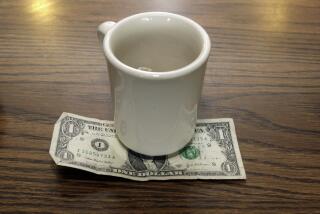Experts Tip Their Hands on Gratuities
- Share via
Alfred Cavaliere of Beverly Hills, who notes that he is “theoretically opposed to tipping” in restaurants but tips anyway (to the tune of at least 15%), writes to ask why the accepted percentage of tips seems to have gone up over the years?
“Forty years ago,” he writes, “a $20 (check) called for a $2 tip. The same meal today would cost $60, and should warrant no more than a $6 tip. But I have to tip $9. Why?”
Secondly, he asks, why should a larger percentage be called for in high-priced restaurants than in lesser ones, “although no greater service was offered”?
Well, to begin with, Cavaliere must have been quite the gourmand if he spent $20 on a meal 40 years ago. According to the 1949-vintage “Dining Out in Hollywood and Los Angeles” by Craig Davidson, an “expensive” dinner in that era would cost “probably more than $3 (per person) without cocktails.” On the East Coast, according to “Knife and Fork in New York” by Lawton Mackall, also published in 1949, top restaurants would cost “more than $4 per person, exclusive of drinks and tips.”
More to the point, though, Davidson’s book states that, while 10% might be an acceptable tip for breakfast and lunch in inexpensive restaurants, 10% to 15% is called for at dinner time. Furthermore, he adds, at top-flight restaurants without a captain, “the average tip is 15%-20% of the check,” and at those with a captain, “the happy medium is 20%-25%, split one-third to the captain and two-thirds to the waiter.” In New York, says Mackall, “the waiter . . . should get 15%; in a night club, 20%.” Going back even further, Rian James, in his “Dining in New York,” published in 1934, recommends tipping a quarter on checks of $1.50 to $2.50, 15% on checks up to $5, and “at least 20%” above $5.
As for why higher percentages are called for at more expensive restaurants, the best answer I can give is simply that, at least in principle , such places do give “greater service.” Waiters are required to know more about food in such places; more changes of silverware and china are invariably called for; table-side service is sometimes required; and it takes more time and skill to properly present, open, decant (if necessary), and pour a bottle of good wine than to pick up a couple of glasses of white zinfandel from the service bar. Service should be better at more expensive restaurants, in other words, and thus should be better compensated.
HERE TODAY GONE TAMAYO: Dr. Stan Kandel, an original majority partner in Spago, and the now-defunct 385 North, has relinquished day-to-day management responsibility at Tamayo, the upscale Mexican restaurant he helped open last year in East Los Angeles. Kandel’s partner in the venture, David Lizarraga is now in charge--though Kandel maintains his financial interest. Humberto Valoso, former general manager of Las Brisas restaurant in Laguna Beach, will some of Kandel’s responsibilities. Meanwhile, high-profile local restaurateur Bob Morris (Gladstone’s 4 Fish, R.J.’s, etc.) has signed on in a consultancy capacity. Morris will introduce a new menu in about two weeks, keeping some popular dishes from the original but adding more traditional Mexican items.
More to Read
Eat your way across L.A.
Get our weekly Tasting Notes newsletter for reviews, news and more.
You may occasionally receive promotional content from the Los Angeles Times.







